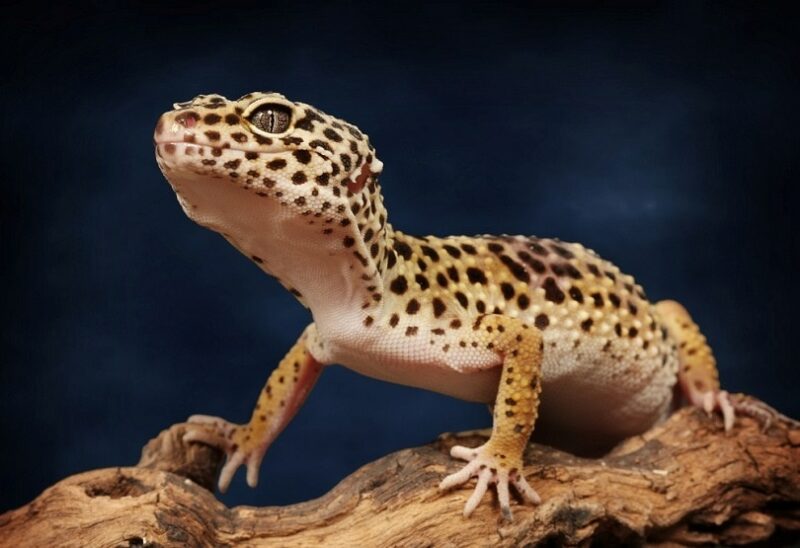[ad_1]
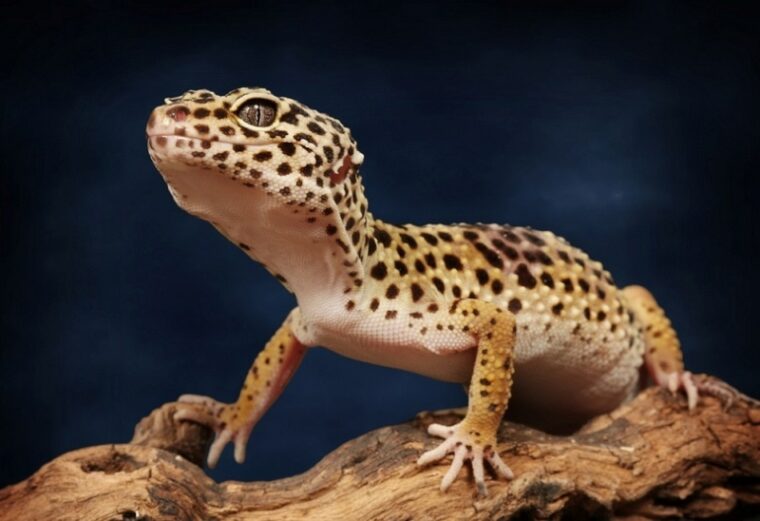
If you have a leopard gecko, you’ve probably wondered why you don’t find huge wet spots in its tank. This begs the question; where is the pee? Do Leos pee? What does their pee look like? As unusual as it may sound, leopard geckos don’t excrete liquid pee. Instead, they produce urates, which is a creamy, pasty semi-solid similar to pee!
Leopard geckos are native to arid desert environments where water is scarce. As such, their digestive systems are built to conserve as much of this precious commodity as possible. The excrement of a healthy gecko is brown on one end and white on the other. While the brown section is regular poop, the white end is semi-solid waste from its kidneys and bladder.
Read on to quench your curiosity about the leopard gecko’s mysterious urates. We will also share practical tips to keep your scaly buddy happy and healthy.
Let’s begin!
What Does Leopard Gecko Pee Look Like?
Leos often pass poop and urate at the same time. The capsule-like waste is roughly half an inch long and is typically brown on one end and white or off-white on the other. The brown stuff that is nearly three-quarters of the waste is regular poop.
That smaller, chalky white or off-white section is urate or solid pee. It can vary in size and shape from a small spot on one end of the poop to a long blob nearly a quarter the size of a gecko’s stool. It is also possible for a healthy pet to produce only urates, especially during breeding season when both males and females barely eat.
Urates are relatively firm, semi-solid, and not wet or runny. However, it is common for excrement to have small amounts of fluid that helps make excretion easier. The damp patch dries quickly and typically lacks that strong, offensive urine stink.
On rare occasions, leopard geckos may have liquid pee. This usually happens if they’re scared or stressed, such as if they’re handled too long. Generally, they try to avoid liquid urine because it wastes water.

Why Solid Pee and Not Regular Liquid Urine?
Leopard geckos produce urates as a sneaky way of their urinary tract systems to save as much water as possible.
These reptiles are native to dry and hot regions where water is a scarce commodity. The pee is typically firmer and can be crushed into a powdery form, especially if a gecko has not had water for several days or weeks. This shows just how little water is lost during excretion.
Although urates are semi-solid, they serve the same function as regular urine because they help clear uric acid and other urinary waste from the body. Still, it will have a relatively mild stink that humans hardly notice unless you decide to get up close and personal.
Is Hydration Important for Leopard Geckos?
Leopard geckos can survive for up to three days without water, though it’s best not to let them go that long. Their body systems ensure only small amounts of water are lost through pee. Still, hydration is crucial to their overall health and well-being. Water aids in effective digestion and ensures your scaly friend maintains optimal health and energy levels.
Although leos get most of the water they need from food, you must also provide constant access to clean water in a shallow bowl. Check the water daily and clean the bowl routinely to prevent the growth of harmful bacteria and fungi.
The lack of water causes digestive problems and dehydration. A dehydrated leopard gecko will poop less, and its urates will seem smaller and dark yellow. There are numerous other symptoms of dehydration, including dry, overly-wrinkled skin (not from an upcoming shed), difficulty shedding, lethargy, and constipation.

How Do You Clean Up Gecko Urate?
Leopard geckos are varied in how messy they are. With most, you will only likely find urate (and poop) on a specific corner of their tank. This should make cleanups easier, mainly if you use the right strategy. Others may be messy and will use their entire tank as a bathroom, even the water or food bowls.
First, avoid cleaning up “fresh” solid waste lest you get grossed out. Irrespective of the substrate, it’s better to wait a while for everything to get a little hard. The poop and urates will be harder and easier to pick using a paper towel or plastic scoop in just half an hour or so.
If you don’t want to deal with a mess, your scooping technique matters. The secret to becoming your scaly friend’s mess-free pooper scooper is to avoid using too much pressure. If you accidentally press the urates with your scoop or hold it too tightly with your paper towel, it will disintegrate into a white powder.
It is crucial to occasionally give your leopard gecko’s tank a good scrub to keep the cage free of bacteria. Ensure the cleaners you use are scent-free, chemical-free, eco-friendly, and safe for reptiles.
The 4 Tips to Keep Your Leopard Gecko Healthy and Happy
Leos are relatively long-lived pets and can easily outlive the majority of popular furry companions. However, the lifespan of your scaly buddy will often depend on the care it receives.
Do you want to give your pet maximum chances of hitting the 20-year life expectancy mark? Here are four tips that can help you keep it happy and healthy.
1. Meet Its Housing Needs
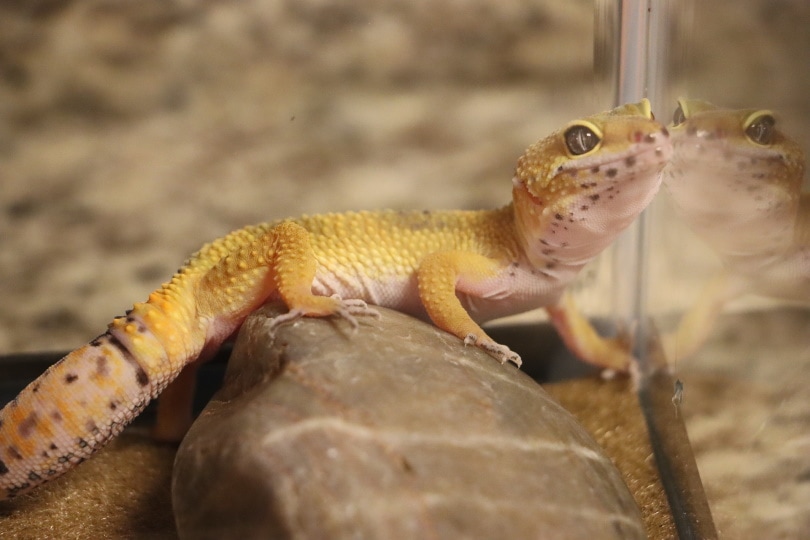
The state of a home sets the mood. If you want to keep your scaly friend happy, you must first invest in creating a housing setup that mimics its natural habitat.
Enclosure Size
One adult leopard gecko needs a vivarium at least 30 cm wide, 60 cm long, and 40 cm high. Even if you want to adopt a hatchling or juvenile, investing in an adult-size enclosure is always better. This will save you from purchasing new equipment once your pet turns into an adult at 12 months of age.
Temperature & Humidity
Apart from tank size, you must also consider the enclosure’s design. Make sure it is well-ventilated and easy to clean. They need a temperature gradient of 75 to 80 degrees on the cool side and 80 to 85 degrees on the hot side. They also need a basking area with a hot spot of 90 to 95 degrees.
Also, make sure your tank features a relatively dry environment. You can use a hygrometer to measure the humidity and ensure it’s between 30 and 40%. You should provide a humidity hide that’s enclosed with moist moss or paper towels that your leopard gecko can access during shedding to help with the process.
Substrate
It is imperative to provide the appropriate, gecko-friendly substrate. Some of the best substrates include paper towels, newspapers, reptile carpets, stone slates, excavator clay, and ceramic tiles. Include some hides that your gecko can use to relax or climb for enrichment.
2. Provide a Balanced Diet
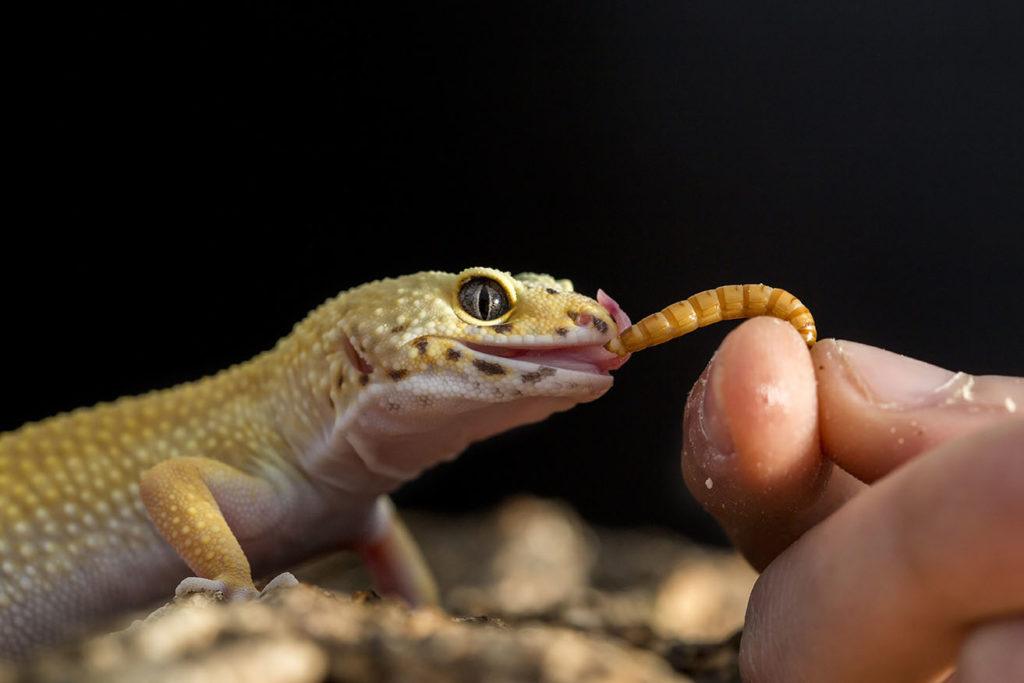
Like all other geckos, leos are insectivorous lizards. They eat bugs and have a particular liking for live ones. Ensure you provide dusted and gut-loaded insects that can pass all the necessary nutrients to your scaly companion.
Leopard geckos are not picky eaters and can enjoy a range of bugs on their menu. Their favorites include dubia roaches, super worms, crickets, mealworms, and waxworms.
Furthermore, you should also dust the meals with a supplement of pure calcium and vitamin A, which is available in reptile-specific formulas. Remember to also put some water in a shallow tray to keep your Leo hydrated and healthy.
3. Minimize Common Causes of Stress

There are some stressors that can make your scaly friend unhappy, scared, or anxious. It is vital to understand your pet’s personality to have an easier time identifying and removing or minimizing potential stress sources.
For instance, leopard geckos are quiet creatures that enjoy hours of silence and solitude. Placing their tank in a busy spot can make them stressed and anxious. Also, your scaly friend can get nervous if its enclosure’s design or state exposes it to potential predators, which is why it’s important to add plenty of hiding spots.
Moreover, Leos can get unhappy because of too much handling. These geckos are hardly ever aggressive but can show they want to return to their tank by urinating on you. They are also high-strung creatures and find quick or startling movements upsetting.
4. Don’t Forget to Have Regular Bonding Sessions
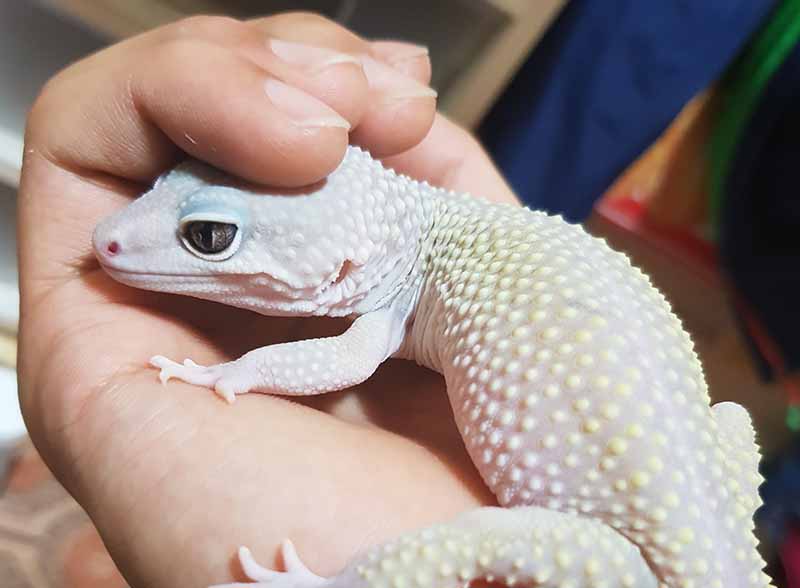
Bonding sessions offer an excellent opportunity for you and your scaly friend to know each other. Although it may take a while before your gecko trusts you enough to allow you to hold it, this will happen eventually.
You must be patient for your pet to trust you and feel comfortable in your presence. Right after adoption, most geckos will want nothing to do with you. Fortunately, they warm up to their owners within three to six weeks and become more receptive to being handled.
As you wait for this to happen, give your scaly friend a name. Once it stops hiding each time it sees you, pick it up gently and support its body, tail, and legs. Also, don’t pet it, as this can trigger anxiety. It’s better to stay put and allow it to walk around freely on your hand or lap.
Final Thoughts
Leopard geckos make excellent scaly friends. They are cute, colorful, quiet, and even-tempered creatures that love being held even by children. Also, they have minimal care requirements because they can spend time alone and have good bathroom manners.
Although you must clean up after them, they produce urates, which are easy and painless to pick.
When cleaning up after your leopard gecko, always check for anomalies that may indicate health problems. For instance, provide more hydration if the urate is yellow. Also, consult your vet if you see colored urates or large pools of liquid around the urate (and poop) on more than three consecutive occasions.
Featured Image Credit: Reinhold-Leitner, Shutterstock
